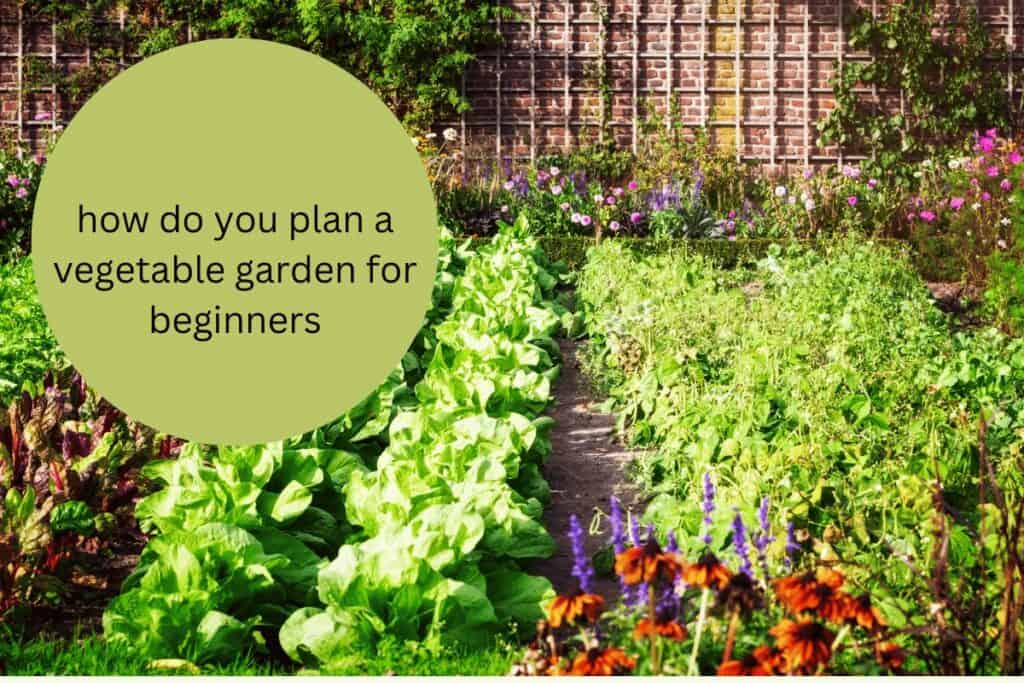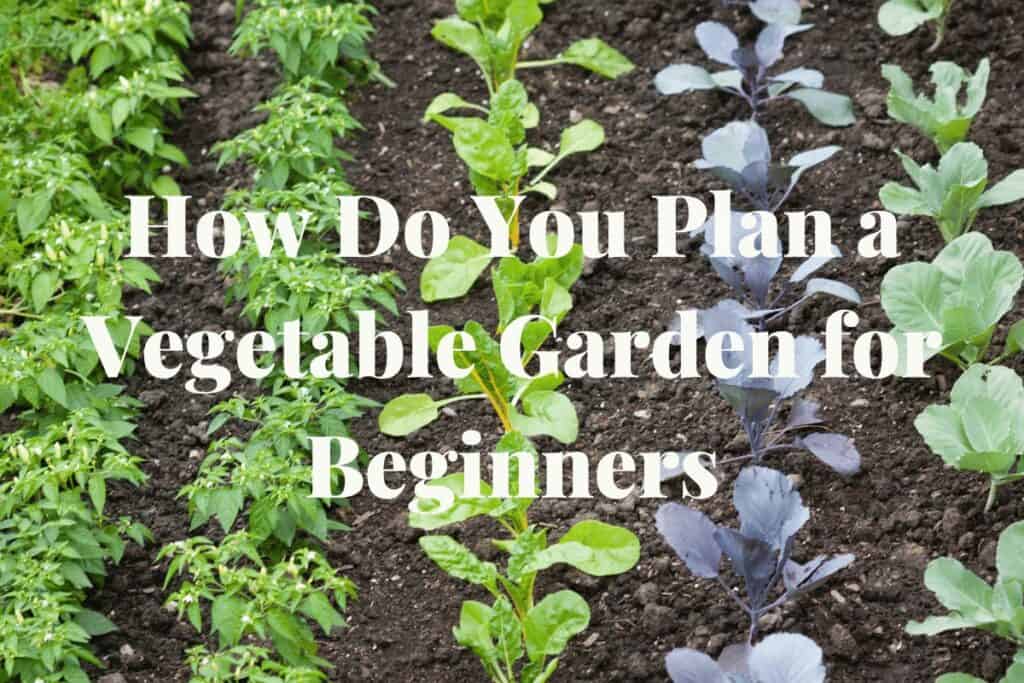We believe that anyone can grow a vegetable garden. With a little planning and preparation, you can be on your way to enjoying fresh, healthy produce right from your backyard. In this article How Do You Plan a Vegetable Garden for Beginners we’ll provide you with all the information to get started on your first vegetable garden.
Are you looking to start your own vegetable garden but don’t know where to begin? Starting a vegetable garden can be a rewarding and enjoyable experience. It’s a great way to get fresh, organic produce while also enjoying the great outdoors. But where do you start? In this article, we’ll provide you with tips and tricks for success so you can plan and start your first vegetable garden.

Choosing the Best Location for Your Vegetable Garden
Choosing the best location for your vegetable garden is one of the most important steps in planning a successful garden. Here are some things to consider when choosing a location for your vegetable garden:
- Sunlight: Most vegetables need 6 to 8 hours of direct sunlight per day to grow properly. Choose a sunny spot in your yard or garden for your vegetable garden. If you don’t have a sunny spot, consider growing vegetables that tolerate shade. [3]
- Soil: Your vegetable garden needs the best soil you can give it. Start with soil that is rich in organic matter, and amend it with compost, manure, or other organic materials. This will help provide the nutrients your plants need to grow and produce healthy vegetables. [1]
- Drainage: It’s important to make sure your garden area drains well and doesn’t stay wet. If you have poorly drained soil where water pools, plant your vegetables in a raised bed or raised row for improved drainage. [3]
Preparing the Soil for Your Vegetable Garden
Once you’ve chosen the location for your vegetable garden, it’s time to prepare the soil. Follow these steps for preparing your soil:
- Remove any weeds or debris from the area where you plan to plant your garden. This will help prevent weed growth and ensure that your plants have access to the nutrients they need.
- Test your soil. This will help you determine what nutrients your soil may be lacking and how much fertilizer to use. You can purchase a soil testing kit at most garden centers or contact your local Cooperative Extension office for assistance.
- Add compost, manure, or other organic materials to your soil to improve its fertility. This will help provide the nutrients your plants need to grow and produce healthy vegetables. [1]
Choosing the Right Plants for Your Vegetable Garden

Choosing the right plants for your vegetable garden is important to ensure a bountiful harvest. Here are some things to consider when choosing plants for your garden:
- Choose plants that are well-suited for your climate. Check with your local Cooperative Extension office for a list of recommended plants for your area.
- Choose plants that are suited to the amount of sunlight your garden receives. If your garden receives full sun, choose plants that require full sun. If your garden is partially shaded, choose plants that tolerate shade. [2]
- Follow the planting formula: 1 extra-large plant per 1×1-foot square; 4 large plants per square; 9 medium plants per square; and 16 small plants per square. Mix and match as you like. [1]
How to Maintaining a vegetable garden
Maintaining a vegetable garden requires consistent care to ensure the health and productivity of the plants. Here are some tips from the provided web search results:
- Water your garden regularly: Watering your garden is important to ensure that your vegetables receive enough moisture to grow properly. According to [1], vegetables need about an inch or two of water per week, every week, and more if it’s extremely hot.
- Mulch your vegetable plants: Adding a layer of organic mulch around your vegetable plants can help suppress weeds, maintain soil moisture, reduce watering, moderate soil temperature, improve soil health, and keep vegetables cleaner. According to [2], pine needles, shredded leaves, straw, and grass clippings from untreated lawns work well as mulch.
- Feed the soil: Healthy soil promotes healthy plants that are more capable of resisting insect and disease problems. Feeding the soil with plenty of compost and well-aged manure can help maintain soil health and provide the nutrients that your vegetables need. According to [3], feeding the soil is key to keeping your garden healthy, green, and growing to its fullest potential.
By following these tips, you can maintain a healthy and productive vegetable garden.
The Importance of Site Selection and Soil Preparation
Before you start planting your vegetable garden, it’s important to choose the right location and prepare the soil. Start by choosing a spot that gets at least six hours of sunlight per day and has good drainage. Avoid areas with standing water or areas that are shaded for most of the day. Once you’ve chosen a location, it’s time to prepare the soil.
The soil is the foundation of your garden, and it’s important to ensure that it’s healthy and fertile. Start by removing any weeds, rocks, or debris from the area. You can then add compost, manure, or other organic matter to the soil to improve its texture and fertility. Mix the organic matter into the soil to a depth of at least six inches.
Choosing the Right Crops for Your Garden
Choosing the right crops for your garden is crucial for success. As a first-time gardener, it’s best to start small with just a few crops that are easy to grow and care for. Some great options include beans, beets, herbs, lettuce, onions, potatoes, radishes, squash, and tomatoes.
When choosing your crops, consider the climate and growing season in your area. Certain crops, like tomatoes, require a long growing season and warm temperatures, while others, like lettuce, prefer cooler temperatures. It’s also important to consider the amount of space each crop requires and how much sunlight it needs.
Tips for Planting and Irrigation
Once you’ve chosen your crops and prepared the soil, it’s time to start planting. Follow the instructions on your seed packets for planting depth and spacing. Water your plants regularly and deeply, making sure that the soil stays moist but not waterlogged.
In addition to regular watering, you may also need to fertilize your plants to ensure that they grow strong and healthy. You can use organic fertilizers like compost or manure, or you can purchase commercial fertilizers.
Conclusion for Planning Your First Vegetable Garden: Tips and Tricks for Success
Growing your own vegetable garden can be a rewarding and enjoyable experience. By following these tips and tricks, you can be on your way to growing your own fresh, healthy produce in no time. Remember to choose the right location, prepare the soil, choose the right crops, and water and fertilize regularly. With a little patience and persistence, you’ll soon be enjoying the fruits of your labor.
FAQS
What kind of dirt is best for a vegetable garden?
The best type of soil for a vegetable garden is well-draining soil that is rich in organic matter. This type of soil will provide the necessary nutrients and moisture for healthy plant growth. Soil can be tested for pH levels and nutrient content, and amendments such as lime or sulfur can be added to adjust the pH as needed.
What month is best to plant vegetables?
The best month to plant vegetables will depend on your climate and the specific vegetables you want to grow. In general, vegetables can be planted in the spring after the last frost date and in the fall before the first frost date. Consult a planting guide for your area to determine the best planting times for specific vegetables [2].
What should I add to my soil before planting vegetables?
Before planting vegetables, it is important to add organic matter to the soil to improve its structure and fertility. Organic matter can include compost, well-rotted manure, leaf mold, or peat moss. These materials will help to retain moisture and nutrients in the soil and improve drainage [2].
How should I arrange my vegetable garden?
The arrangement of your vegetable garden will depend on the size and shape of your plot. A common arrangement is to create raised beds or rows with paths in between for easy access. Consider the spacing requirements of your vegetables and arrange them accordingly. Group plants together based on their water and sunlight needs. Consider companion planting, which involves planting certain vegetables together to improve growth and deter pests.
How do you start a vegetable garden plot?
To start a vegetable garden plot, select a location that receives at least six hours of sunlight per day and has well-draining soil. Remove any grass or weeds from the area and till the soil to a depth of 8-12 inches. Add organic matter to the soil if it is poor or compacted. Create raised beds or rows for planting and mark the rows with stakes or string. Plant your vegetables according to their spacing requirements and water them regularly.
How do you make a simple vegetable garden plan?
To make a simple vegetable garden plan, start by selecting a location for your garden that receives at least six hours of sunlight per day. Determine the size of your garden and choose the vegetables you want to grow based on their spacing requirements. Use a planting formula to determine the number of plants to include in each square foot of the garden.
What are the best veggies for a first-time gardener?
Latest Posts
- What Types of Lettuces Can You Grow?

- How to Plant Onion Seeds for Maximum Germination

- How to Plant Parsnip Seeds for Maximum Germination

- How to Plant Mushroom Seeds for Maximum Germination

- How to Plant Lettuce Seeds for Maximum Germination

- How to Plant Kale Seeds: A Step-by-Step Guide to Maximum Germination Success!





